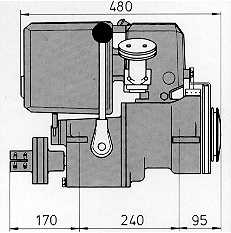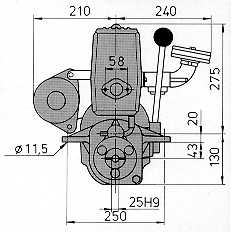



To ensure reliable operation the engine must be mounted with great care. The fore and aft angle of inclination is recommended at 5°. The maximum of 10° must not be exceeded. The illustrations below show the most important dimensions that need special attention during the mounting (all dimensions in mm).


The engine bed should be sturdy and of solid construction. It is advisable to make the fore and aft bearers as long as possible, so that thrust from the propellor will be transmitted through frames or ribs. The bed must also be firmly fixed to the transverse members.
It is advisable to arrange the height of the engine bed so that shims or thin packing pieces can be inserted under the engine bearers. It will then be possible to obtain accurate alignment by removing or increasing the number of shims. Alignment should be checked at the beginning of and at least once during each season, as it is common for some craft to undergo slight changes in shape according to weather and drying out due to laying up conditions.
It is most important that the engine shaft and propellor shaft are in accurate alignment. The propellor shaft does not need any extra thrust bearing, as the rear bearing of the engine is capable of receiving the thrust. The propellor shaft system and the engine should first be assembled approximately in line. The exact centralisation and lining up is carried out by moving the engine little by little, after the propellor shaft system has been finally installed. When checking the final alignment of the engine, first tighten the fixing bolts of the engine, then remove the screws and the flexible disc of the coupling. The position of the engine is correct when the coupling flanges are centralised and completely parallel in all directions. The parallellism of the flanges can be confirmed by means of a feeler guage. If the distance between the flanges varies in any direction, the engine has to be moved sufficiently to correct any misalignment. When correct alignment is achieved, reconnect the coupling. Remove the spark plug and turn the shaft by hand. If the shaft rotates freely and evenly the engine/propellor shaft alignment is correct.
When using a stern tube provided with a rubber-sleeve-mounted front bearing, the front end of the propellor shaft has to be centralised carefully to the stern tube before final checking is made. The centralisation is best achieved by disconnecting the sleeve, sliding the bearing assembly forward and locating the shaft in the tube with small wedges.
Despite the presence of cooling water, exhaust gases leaving the exhaust gas collector are still quite hot. The temperature of exhaust gases depends on the load and it can be as high as 300°C.
If a hot exhaust is acceptable it can be left dry and the cooling water can be led from the cylinder directly to a discharge-overboard fitting. However, a hot exhaust pipe is generally to be avoided because of thermal radiation and the risk of fire.
The preferred system is to raise the exhaust pipe immediately after the exhaust gas collector to a height sufficient to prevent sea water getting through the exhaust pipe to the engine.
If there is no need to use a water jacket on the rising part of the exhaust pipe, cooling water is led directly into the exhaust pipe. In such a case the rising part of the exhaust pipe is hot and it has to be isolated and insulated from its surroundings. However, because the temperature of the cooled part of the exhaust pipe does not exceed 100°C, that part of the pipe can be made out of suitable petrol-resistant plastic or rubber materials.
In some cases it is not possible to get the bend of the exhaust pipe high enough immediately behind the engine. In such cases, a water jacket can be fitted immediately behind the engine, with a high bend further aft.
If neither bend is high enough, but cooling of the exhaust is still needed, it can be arranged by leading a small amount of the cooling water through a regulator cock into the exhaust pipe. In this system, the main part of the cooling water is led from the cylinder directly through a hull fitting, as it is in a "hot exhaust" system. When using this system, the regulator cock must be opened immediately after starting the engine and closed before stopping the engine, if the engine is below or on the waterline.
The exhaust pipe must always be installed so that any water coming past the exhaust pipe or condensing from exhaust gas in the exhaust pipe cannot flow into the engine.